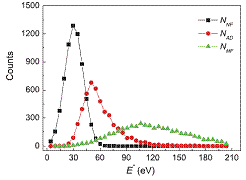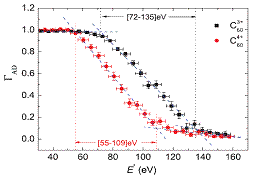Researchers in the Atomic & Molecular Dynamics Group at Institute of Modern Physics, Chinese Academy of Sciences, taking charge-selected C603+ and C604+ as model systems, experimentally explored the fragmentation phase transition (FPT) occurring in atomic clusters and directly observed above some important features of the FPT.
In a series of theoretical works from Gross’s group, the calculated caloric curve for a cluster system was found to be divided into four parts: after an initially rising, a plateau and a backbending are present before the curve rises again. The results indicate a multistage FPT corresponding to a stepwise appearance of typical fragmentation phenomena from no fragmentation (NF) through asymmetrical dissociation (AD) and multifragmentation (MF) to complete fragmentation (CF). Furthermore, the calculated FPT has significant dependence on the cluster charge. For example, charging the cluster shifts the transition to lower excitation energies and forces the transition region to narrow or even disappear.
The experiment focused on the exploration of above multistage transformation and charge effects predicted by Gross’s group, and was performed in the LASIM at the Center for Natural Resource Studies (CNRS), the university Lyon 1. The large-range scan of the energy deposited in charge-selected C603,4+ was achieved using a recently developed collision-induced dissociation under energy control (CIDEC) technique. The multistage transformation was obtained by showing the energy-dependent evolution of fragmentation phenomena. The charge effect was demonstrated by a comparison between the two systems with different initial charges.
Above experimental results have been published in Physical Review A, 87 (2013) 063201 .

Fig. 1 Population distributions of fragmentation phenomena associated with C604+∗ parent ions as a function of excitation energy.(Image by IMP)

Fig. 2 Ratio parameter associated with C60r+∗ (r = 3,4) parent ions as a function of excitation energy, where the parameter is used to characterize the phase transition. (Image by IMP)

